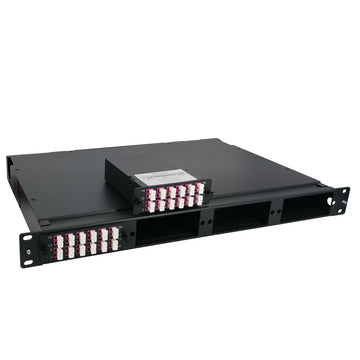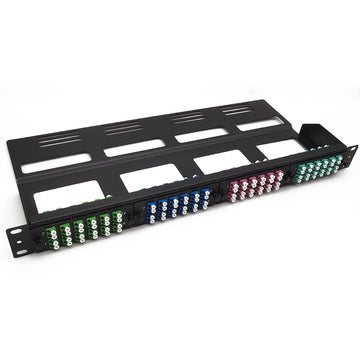What is Fiber Optic Adapter
What is Fiber Optic Adapter?
Fiber optic adapters (also known as Fiber couplers, Fiber Adapter ) are designed to connect two optical cables together. They have a single fiber connector (simplex), dual fiber connector (duplex) or sometimes four fiber connector (quad) versions. The optical fiber adapter can be inserted into different types of optical connectors at both ends of the optical fiber adapter to realize the conversion between different interfaces such as FC, SC, ST, LC, MTRJ, MPO, MTP and E2000, and is widely used in optical fiber distribution frames (ODFs) Instruments, providing superior, stable and reliable performance.
How Fiber Optic Adapter Works?
The optical fibers are connected by an adapter through its internal open bushing to ensure the maximum connection between the optical connectors. In order to be fixed in a variety of panels, the industry also designed a variety of finely fixed flange.
Fiber Optic Adapter types
LC Fiber Optic Adapter
The LC-type connector is a well-known BELL (Bell) Institute of research and development, the use of convenient modular jack (RJ) latch mechanism made. The pins and sleeves used are half the sizes used for normal SC, FC, etc., at 1.25mm. This will increase the density of fiber optic connectors in fiber distribution frames. The LC Series is small form factor (SFF), utilizing 1.25mm diameter optical ferrules. They offer high-density packaging and high-optical performance, and come with simplex, duplex, and quad ports and more for singlemode, multimode, and APC applications.
| LC Standard Fiber Optic Adapter |  |
| LC Slim-Pack Fiber Optic Adapter |  |
| LC Multi-Port Fiber Optic Adapter |  |
| LC Fiber Optic Adapter w/ Dust Protection |  |
SC Fiber Optic Adapter
This is a kind of optical fiber connector developed by Japan NTT Corporation. The shell is rectangular, the pin and the coupling sleeve used in the structure of the same size and FC type. One end of the pin to use more PC or APC grinding method; the casting method is the use of plug pin type, without rotation. Such connectors are inexpensive, easy to plug and unplug, low insertion loss variations, high compressive strength, and high installation density.
| SC ADAPTER MOLDED IN FIBER SYSTEM |  |
| SC STANDARD ADAPTER |  |
| SC AUTO SHUTTER ADAPTER |  |
| SC EXTERNAL SHUTTER |  |
MTP/MPO Fiber Optic Adapters
Unlike the single-core SC fiber optic adapters, the SC fiber optic adapters are internally equipped with a ceramic ferrule that is precisely aligned through the ferrule when the SC connector ferrule is connected, while the MPO / MTP adapter is connected using an MPO / MTP Precise connection of two guide holes with a diameter of 0.7mm and a guide pin on the left and right ends of the ferrule. MPO / MTP adapters are widely used in communication system base stations, optical fiber distribution frames (ODFs) in building rooms, MPO / MTP cassette module, and various test instruments.

FC Fiber Optic Adapter
This fiber optic adapter was first developed by Japan NTT. FC is an acronym for FERRULE CONNECTOR, indicating that its external reinforcement is the use of the metal sleeve, fastening the way for the buckle. The earliest, FC type connector, the docking end of the ceramic pin. Such connectors are simple in structure, easy to operate and easy to manufacture. However, the fiber end face is more sensitive to dust, and it is easy to produce Fresnel reflection and it is difficult to improve the return loss performance. Later, this type of connector has been improved, the use of docking the spherical end of the pin (PC), while the external structure has not changed, making the insertion loss and return loss performance has been greatly improved.
DIN Fiber Optic Adapter
This is a connector developed by Germany. The pins and coupling sleeves used in this connector are the same size as the FC type and the PC process is used for the end face processing. Compared with the FC type connector, the structure is more complex, and the internal metal structure has a control pressure spring to prevent the end face from being damaged due to the excessive insertion pressure. In addition, this connector has higher mechanical accuracy and therefore smaller insertion loss values.
MTRJ Fiber Optic Adapter
MTRJ started with the MT connector developed by NTT with the same latching mechanism as the RJ-45 type LAN electrical connector. Alignment of the optical fiber with guide pins mounted on both sides of the small bushing made it easy to communicate with the optical transceiver Machine connected to the connector end of the optical fiber for the dual-core (0.75MM spacing) array design is mainly used for data transmission next generation high-density fiber optic connectors.
MU Fiber Optic Adapter
The MINIATURE UNIT COUPLING connector is the world’s smallest single-core fiber optic connector developed by NTT based on the currently used SC-type connector. The connector uses a 1.25MM diameter sleeve and self-holding mechanism, the advantage is that it can achieve high-density installation. NTT has developed the MU connector family with MU’s L.25MM diameter bushings. They have socket type connectors for optical cable connections; backplane connectors with the self-holding mechanism and simplified sockets for connecting LD / PD modules and plugs Wait. Demand for MU-type connectors will also grow rapidly as fiber-optic networks become more capable of larger bandwidths and DWDM technologies are widely used.
How to choose a fiber optic adapter?
Due to the wide variety of fiber optic adapters and the similar appearance of fiber optic adapters from different vendors, you may not know how to choose. In general, you should consider the following two tips when choosing a fiber optic adapter.
Fiber Cable Type
If the fiber adapter needs to be connected to the same fiber cable type and connector, a fiber optic adapter with a square, rectangular or circular interface can be used. If the type of cable to be connected is different, a hybrid fiber adapter is required. This hybrid fiber adapter can connect any two types of fiber patch cords together. Due to the wide variety of hybrid fiber optic adapters, it is important to know what type of cable to connect before purchasing.
The Sleeve Material of fiber adapter
Alignment sleeve is the most important component of fiber optic adapters. Some manufacturers choose metal as the material for the alignment bushings, but ceramic-made fiber optic adapters have proven to work much better than using metal as the alignment bushing. The fiber optic adapter, because the crystal structure of the ceramic is very hard and does not deform over time like metal, so it can achieve fast alignment and high-precision fiber end-face connection.
How to Cleaning Fiber Optic Adapter?
Although the fiber optic adapter is relatively small and belongs to the small part of the fiber optic cabling, it does not affect its importance in the fiber optic cabling system. Like other fiber optic equipment, it needs to be cleaned. There are two main cleaning methods, namely contact and non-contact cleaning.
1. Contact cleaning method
(1) Dust-free wiping paper or dust-free cleaning cloth; use dust-free paper or dust-free cloth with sewage alcohol to wipe the end face of the fiber optic connector.
(2) Cassette type optical fiber cleaning box; a special role of wiping tape is installed in the rollable casing, and the principle is to use the strong adhesive on the wiping tape to stick the dirt on the end face of the fiber connector.
(3) Special fiber cleaning pen; fiber-optic cleaning pen is specially used to clean the inside of the fiber adapter or the ferrule end face. The method is very simple. The end of the refill is inserted into the ceramic sleeve of the adapter and can be cleaned by a single push. End face.
2. Non-contact cleaning method
(1) Ultrasonic cleaning method Nowadays, the ultrasonic cleaning instrument on the market adopts this cleaning method, and the cleaning liquid is turned into an ultrasonic “liquid column” to be sent out to the end face of the fiber connector.
(2) High-pressure air blowing method; the cleaning liquid is shown on the end face of the fiber connector, and then the high-pressure gas is used to align the end face of the connector to clean the end face.












